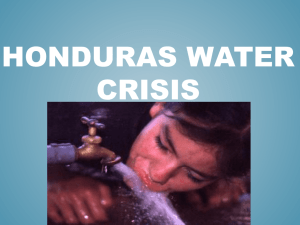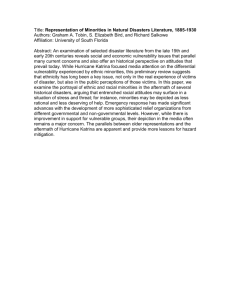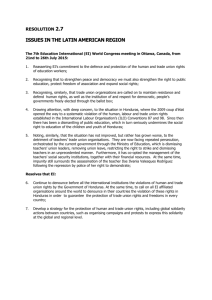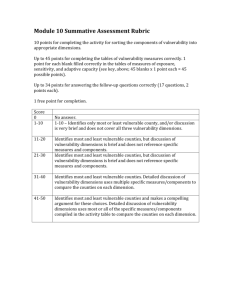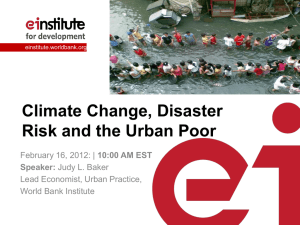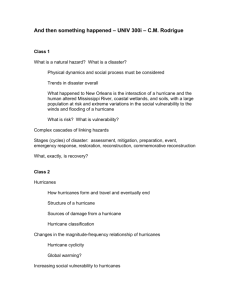Honduras Case Study outline - START
advertisement
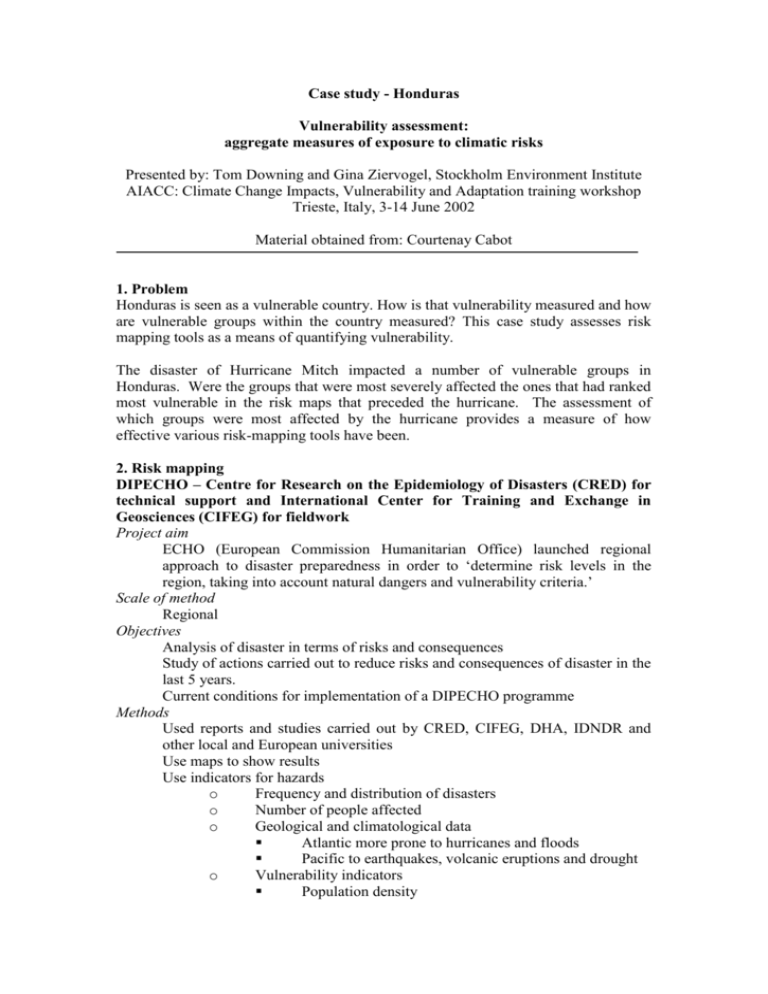
Case study - Honduras Vulnerability assessment: aggregate measures of exposure to climatic risks Presented by: Tom Downing and Gina Ziervogel, Stockholm Environment Institute AIACC: Climate Change Impacts, Vulnerability and Adaptation training workshop Trieste, Italy, 3-14 June 2002 Material obtained from: Courtenay Cabot 1. Problem Honduras is seen as a vulnerable country. How is that vulnerability measured and how are vulnerable groups within the country measured? This case study assesses risk mapping tools as a means of quantifying vulnerability. The disaster of Hurricane Mitch impacted a number of vulnerable groups in Honduras. Were the groups that were most severely affected the ones that had ranked most vulnerable in the risk maps that preceded the hurricane. The assessment of which groups were most affected by the hurricane provides a measure of how effective various risk-mapping tools have been. 2. Risk mapping DIPECHO – Centre for Research on the Epidemiology of Disasters (CRED) for technical support and International Center for Training and Exchange in Geosciences (CIFEG) for fieldwork Project aim ECHO (European Commission Humanitarian Office) launched regional approach to disaster preparedness in order to ‘determine risk levels in the region, taking into account natural dangers and vulnerability criteria.’ Scale of method Regional Objectives Analysis of disaster in terms of risks and consequences Study of actions carried out to reduce risks and consequences of disaster in the last 5 years. Current conditions for implementation of a DIPECHO programme Methods Used reports and studies carried out by CRED, CIFEG, DHA, IDNDR and other local and European universities Use maps to show results Use indicators for hazards o Frequency and distribution of disasters o Number of people affected o Geological and climatological data Atlantic more prone to hurricanes and floods Pacific to earthquakes, volcanic eruptions and drought o Vulnerability indicators Population density o Economic loss Losses from disasters reduced GDP where countries should have increased GDP in those years had the disasters not occurred. Findings The exercise highlights Honduras as an area of high risk, and therefore in need of analysis at a local level. Figure 1: DIPECHO’s Risk Map of Central America Red = High Risk Outcomes communication: in general for the project Preventative planning on the occupation and use of land Limit human occupation of high risk areas Reduction of the probability of events Possible for landslides, floods and droughts. Eg. Drainage and slope stabilisation can minimise the impact of a landslide. Miminimise the effects of a disaster phenomena Contain or deviate the disaster phenomena Make buildings resistant to potential disaster phenomena Actions carried out in the region in the field of preparedness With respect to hurricanes: The cost of disasters caused by hurricanes is in increasing but the number of victims has dropped primarily because of improvements in tracking the trajectories. The trajectories are still unpredictable and so unnecessary warnings are often given. Oxfam Project aim To develop a tool not for disaster experts but for local experts Objectives To assess risks, vulnerability and local capacity at a regional level and adapted for local-level application To develop the capacity of institutions to tackle emergency situations Methods Qualitative and quantitative indicators: Analysis of threats: incidence and distribution Natural – hurricanes, seismic activity, volcanic activity, floods, landslides, tsunamis, drought Human agency – conflicts, technology-related emergencies, abuse of natural resources Analysis of vulnerability Relationship between level of risk, local capacities and living conditions of local communities o Face a variety of physical risks o Exposed to a combination of threats o Areas with high levels of economic production and so of strategic importance o Good communication and road networks o High population density Modified according to trace indicators, capacity to predict occurrences, communication systems, capacity of healthcare systems, general levels of education and levels of disease Analysis of local capacity - documented in risk map 1st – institutional framework for management of disasters at a regional, national and local level 2nd – assesses current capacity from perspective of civil society 3rd – considers initiatives for developing existing capacity such as management of information regarding disasters Conclusions Accurate level of approximation in the 1st phase Absence of multi-hazard analysis and mapping Identifies principal players in the context of disasters Outcomes communication North-western, western and southern Honduras were classified as very high risk areas. Nine out of ten houses are on the poverty line and highest levels of illiteracy. World Bank with UNEP (United Nations Environment Programme) and CIAT (International Center for Tropical Agriculture) Project aim To decide where mitigation and reconstruction projects should focus Methods The rigorous study identified and mapped a wide range of indicators for measuring and tracking sustainability in Central America. The four layers of maps of vulnerability indices and indicators were: 1. Environmental – forests, rivers, topography, slopes, soil permeability and vegetation, to provide an index for flood and landslide risk areas 2. Population – total population per village 3. Social – percentage of poor people (when combined with population index identifies the largest groups of poor people) 4. Infrastructure – roads and electricity lines, weighted according to whether they are primary, secondary or tertiary, village size and location, location of health centres and slopes. Scale Local Findings The model was applied to vulnerability in Honduras at the county level, with the objective of deciding where mitigation and reconstruction projects should be focused. Figure 2 shows the ten top risk municipalities that could be the focus of future work. LEGEND Red = Top ten high risk municipalities Orange = 10-25 Yellow = 25-60 Figure 2: Risk Map of Honduras – Top 60 High Risk Municipalities Outcomes communication The regional framework gives the user a useful platform for the development of more ‘custom-made’ frameworks at a local level. The selected indices should be redefined appropriately depending on the level of analysis Visualisation and dissemination of information should be made flexible, depending on the users’ needs. 3. Event: Hurricane Mitch Overview Honduras is situated in a vulnerable region in terms of seismic activity and hurricane exposure. It has a population of just fewer than 6 million people with 44% of the population urbanised. In October 1998, Hurricane Mitch hit Central America (Figure 3), which affected 3.5 million people affected (11% of the population) and resulted in approximately 9,000 deaths. Total damage was estimated at $6 billion, 17% of GDP. Honduras suffered most, with nearly 6,000 dead, 1.5m affected, and economic losses of nearly $4 billion, equivalent to 80% of 1997 GDP. The majority of damage was due to landslides, and is closely related to land degradation and deforestation due to agriculture. Landslides on hillsides and swollen rivers swept away bridges, highways, and infrastructure. The intensity of the rains, the wide area affected, and the man-made damage in catchment basins all contributed to the storm’s impact. Landslides and flooding accounted for the majority of victims Figure 3: Path of Hurricane Mitch 4. Evaluation Vulnerability Mitch made landfall and caused the greatest damage on the east coast of Honduras as well as inflicting damage in the low lying areas of the southwest. It is widely reported that the lowest income groups in these areas were most affected by the storm. A World Neighbors study of Central America reports that the poorest people in both urban and rural areas suffered greatest. The most vulnerable groups were those living and farming on hillsides and near rivers. Morris et al report that the destruction was greatest on the Atlantic coast and on the southern watersheds. They also note that, while the poorest groups in Honduras were in the mountainous west away from the impacts of Mitch, they were nonetheless significantly impacted because of their inability to respond and adapt to what little damage the area did experience. A UN assessment of damage caused by Mitch in Central America reports that most of the affected population were low income groups. By contrast, the analyses by Oxfam and the World Bank identified the most vulnerable populations on the west coast. Whilst some of these populations were affected, the map does not point to the most vulnerable populations on the east coast. Given that these types of maps are important for focusing disaster preparedness and mitigation efforts, as well as funding and development activities, it is critical that these disparities are understood. A number of additional indicators are identified that increase understanding of risk in Honduras at a local level – accessibility, land use, capacity, and gender. Accessibility In a separate analysis, the World Bank project identifies accessibility to the poor as an important indication of risk. A risk map overlaying poverty and flooding after Mitch does not accurately identify vulnerability. However, when this map is overlaid with loss of accessibility to poor (to deliver food aid, etc) the model is indicative of vulnerability. Interestingly, their first analysis included infrastructure as one of the four indices, but the combination of many variables seems to have watered down the magnitude of the relationship between infrastructure, poverty, and hazards. Land Use Much of the devastation caused by Mitch was related to agricultural land use. A World Neighbors study demonstrated that land farmed with sustainable methods fared better in Mitch than conventional plots. Land farmed with sustainable methods fared better on vital indicators such as topsoil depth, moisture content and surface erosion. Whilst the results were more mixed with regard to landslides and gullies, the study hypothesises that this is due to farms being located on steep slopes and a lack of conservation in the entire hillside, as opposed to the individual plot. The poor are almost always marginalized to steep or undesirable locations, and therefore will be more vulnerable to heavy rains caused by storms. Risk cannot be critically assessed without an understanding of environmental issues, including a detailed analysis of the types of land use. Capacity Local capacity to respond to emergencies acts as a counterbalance to vulnerability and the two should be analysed together. For example, six months prior to Mitch, a pilot project in community emergency preparedness was established in the rural municipality of La Masica in Honduras. La Masica was equipped for Mitch, vacated the area, and hence was one of the few in its area to report no deaths. Gender Whilst there are no specific data on the number of women killed in Honduras due to Mitch, gender has been identified as an important indicator of vulnerability. Women in poor countries tend to have lower health and educational status. In Honduras in 1990, 72% of families headed by women lived in extreme poverty. In addition to short term vulnerability, women are generally found to have a harder time recovering in the long term after a disaster. 4. Lessons learned The Oxfam and World Bank studies are high quality, detailed analyses of risk, and yet, when compared with Mitch and its impacts on Honduras do not fully identify those populations that were most at risk. The comparison shows that poverty indicators alone are not sufficient to explain vulnerability, but rather accessibility to the poor and gender are important qualifying factors. Farming practices are an important indication of the vulnerability of the land, and hence the people. Early warning systems and other capacity measures are an important counterbalance to vulnerability. This analysis raises three important issues about context: 1. Honduras must be assessed in both a regional and a local context. For example, at a regional level, Honduras is high risk compared to other countries in Central America. Therefore, whilst there are local differences in vulnerability, the country as a whole should be the focus of aid and development at a regional level. 2. Indicators must be analysed in the context of a broader framework of vulnerability. The focus of risk mapping is on quantifiable data, because it gives a definitive view of indicators that can be compared across municipalities, countries and regions, allowing prioritisation of high risk populations. However, if these quantifiable models are not qualified with understanding of local political, social, and economic conditions, the value of a risk map, a powerful tool if used correctly, could be diminished. 3. The political, social and economic contexts are very important in understanding risk, and deserve elaboration. The politics of disasters and risk reduction have wide ranging implications, and may not always be focused on reducing vulnerabilities. For example, in El Salvador post- Mitch, very little has been done to increase capacity and minimise risk from the next natural disaster. The roots of hazard vulnerability in El Salvador are embedded in a long history of elite control of the land. Given the highly politicised nature of land tenure, there is little incentive to resettle vulnerable people on safer lands, despite the impacts of Mitch. Thus, whilst risk mapping is an important tool to identify vulnerable populations, it says little about whether the political culture will seek to implement mitigation measures for the most vulnerable. The social and economic conditions of risk are clearly highlighted in an example from Nicaragua. From a hazard perspective, the impacts of Mitch were varied. In some areas, the poor were the most affected because their houses were built on land exposed to hazards, the only land available to them. In other areas, some of the best irrigated land belonging to wealthier groups was destroyed because it was located in valleys, whilst the low quality land belonging to the poor was not. However, the socio-economic relationships of these groups has significant implications for the vulnerability of the poor. Whilst in some cases they may have lost less land, the impact was more closely tied to their vulnerability as dictated by their role in the local economy and their socio-economic relations with the wealthier farmers. Risk has to be inserted in the context of livelihoods as opposed to simply the loss of land.
